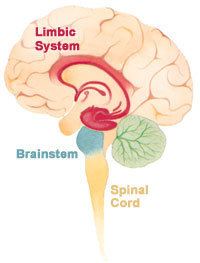Specialty neurology ICD-9-CM 323.81 MeSH D020363 | ICD-10 G04.81 DiseasesDB 30707 | |
 | ||
Limbic encephalitis is a form of encephalitis, a disease characterised by inflammation of the brain. Limbic encephalitis is caused by autoimmunity: an abnormal state where the body produces antibodies against itself. Some cases are associated with cancer and some are not. Although the disease is known as "limbic" encephalitis, it is seldom limited to the limbic system and post-mortem studies usually show involvement of other parts of the brain. The disease was first described by Brierley and others in 1960 as a series of three cases. The link to cancer was first noted in 1968 and confirmed by later investigators.
Contents
- Symptoms and signs
- Cerebrospinal fluid CSF
- Neuroimaging
- Neuro electrophysiology
- Diagnosis
- Antibodies against intracellular neuronal antigens
- Antibodies against cell membrane antigens
- Treatment
- References
The majority of cases of limbic encephalitis are associated with a tumour (diagnosed or undiagnosed). In cases caused by tumour, cure is only achieved when the tumour is removed completely (this is not always possible). Limbic encephalitis is classified according to the auto-antibody that causes the disease.
The most common types are:
Since 1999 following a report of case of a 15 -year-old teenager of Indian descent from South Africa, subacutely developed memory loss subsequent to herpes simplex type 1 encephalitis similar cases of non paraneoplastic LE its association with auto-antibody and response to steroid has been described. Limbic encephalitis associated with voltage‐gated potassium channel antibodies (VGKC‐Abs) may frequently be non‐paraneoplastic. A recent study of 15 cases of limbic encephalitis found raised VGKC‐Abs associated with non‐paraneoplastic disorders and remission following immunosuppressive treatment.
Symptoms and signs
Symptoms develop over days or weeks. The subacute development of short-term memory deficits is considered the hallmark of this disease, but this symptom is often overlooked, because it is overshadowed by other more obvious symptoms such as headache, irritability, sleep disturbance, delusions, hallucinations, agitation, seizures and psychosis, or because the other symptoms mean the patient has to be sedated, and it is not possible to test memory in a sedated patient.
Cerebrospinal fluid (CSF)
Examination of cerebrospinal fluid (CSF) shows elevated numbers of lymphocytes (but usually < 100 cells/µl); elevated CSF protein (but usually <1.5 g/l), normal glucose, elevated IgG index and oligoclonal bands. Patients with antibodies to voltage-gated potassium channels may have a completely normal CSF examination.
Neuroimaging
MRI brain is the mainstay of initial investigation pointing to limbic lobe pathology revealing increased T2 signal involving one or both temporal lobes in most cases.
Serial MRI in LE starts as an acute disease with uni- or bilateral swollen temporomesial structures that are hyperintense on fluid attenuation inversion recovery and T2-weighted sequences. Swelling and hyperintensity may persist over months to years, but in most cases progressive temporomesial atrophy develops.
PET CT scan: Not an essential investigation but can help in suspected cases with MRI negative for early diagnosis.
Neuro-electrophysiology
EEG: Mostly nonspecific slowing and epileptiform activity arising from temporal lobes.
Diagnosis
The diagnosis of limbic encephalitis is extremely difficult and it is usual for the diagnosis to be delayed for weeks. The key diagnostic test (detection of specific auto-antibodies in cerebrospinal fluid) is not routinely offered by most immunology laboratories. Some of the rarer auto-antibodies (e.g., NMDAR) have no commercially available assay and can only be measured by a very small number of research laboratories worldwide, further delaying diagnosis by weeks or months. Most patients with limbic encephalitis are initially diagnosed with herpes simplex encephalitis, because the two syndromes cannot be distinguished clinically. HHV-6 (human herpes virus 6) encephalitis is also clinically indistinguishable from limbic encephalitis.
There are two sets of diagnostic criteria used. The oldest are those proposed by Gultekin et al. in 2000.
A revised set of criteria were proposed by Graus and Saiz in 2005.
The main distinction between the two sets of criteria is whether or not the detection of a paraneoplastic antibody is needed for diagnosis.
Antibodies against intracellular neuronal antigens
The main antibodies within this group are those against Hu, Ma2, CV2, amphiphysin and Ri. The syndrome of anti-Ma2 encephalitis may be clinically mistaken for Whipple's disease.
Antibodies against cell membrane antigens
The main antibodies within this group are those against anti-N-methyl-D-aspartate receptors (NMDAR) and the voltage-gated potassium channel-complex (VGKC-complex). Anti-NMDAR encephalitis is strongly associated with benign tumours of the ovary (usually teratomas or dermoid cysts). Anti-VGKC-complex encephalitis is most often not associated with tumours.
Patients with NMDAR encephalitis are frequently young women who present with fever, headache and fatigue. This is often misdiagnosed as influenza, but progresses to severe behavioural and personality disturbance, delusions, paranoia and hallucinations. Patients may therefore initially be admitted to a psychiatric ward for acute psychosis or schizophrenia. The disease then progresses to catatonia, seizures and loss of consciousness. The next stage is hypoventilation (inadequate breathing) requiring intubation, orofacial dyskinesia and autonomic instability (dramatic fluctuations in blood pressure, temperature and heart rate).
Treatment
Limbic encephalitis is a rare condition with no randomised-controlled trials to guide treatment. Treatments that have been tried include intravenous immunoglobulin, plasmapheresis, corticosteroids, cyclophosphamide and rituximab.
If an associated tumour is found, then recovery is not possible until the tumour is removed. Unfortunately, this is not always possible, especially if the tumour is malignant and advanced.
